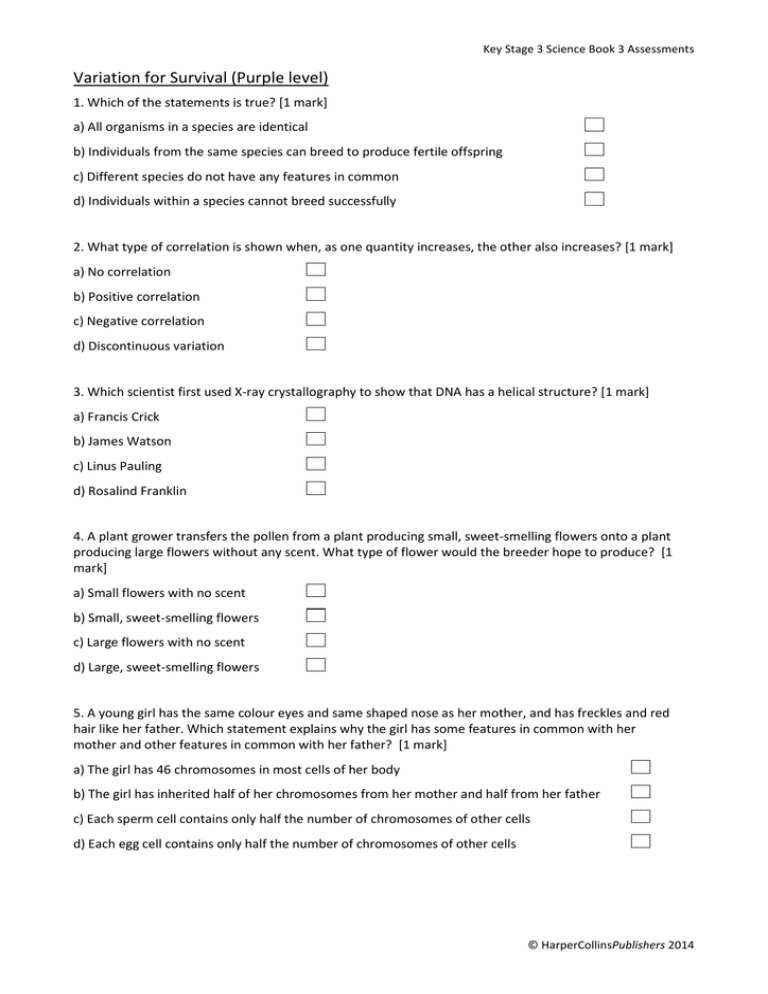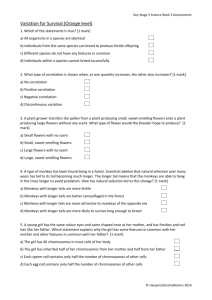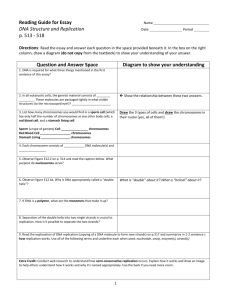Variation_for_Survival_Purple_Questions
advertisement

Key Stage 3 Science Book 3 Assessments Variation for Survival (Purple level) 1. Which of the statements is true? [1 mark] a) All organisms in a species are identical b) Individuals from the same species can breed to produce fertile offspring c) Different species do not have any features in common d) Individuals within a species cannot breed successfully 2. What type of correlation is shown when, as one quantity increases, the other also increases? [1 mark] a) No correlation b) Positive correlation c) Negative correlation d) Discontinuous variation 3. Which scientist first used X-ray crystallography to show that DNA has a helical structure? [1 mark] a) Francis Crick b) James Watson c) Linus Pauling d) Rosalind Franklin 4. A plant grower transfers the pollen from a plant producing small, sweet-smelling flowers onto a plant producing large flowers without any scent. What type of flower would the breeder hope to produce? [1 mark] a) Small flowers with no scent b) Small, sweet-smelling flowers c) Large flowers with no scent d) Large, sweet-smelling flowers 5. A young girl has the same colour eyes and same shaped nose as her mother, and has freckles and red hair like her father. Which statement explains why the girl has some features in common with her mother and other features in common with her father? [1 mark] a) The girl has 46 chromosomes in most cells of her body b) The girl has inherited half of her chromosomes from her mother and half from her father c) Each sperm cell contains only half the number of chromosomes of other cells d) Each egg cell contains only half the number of chromosomes of other cells © HarperCollinsPublishers 2014 Key Stage 3 Science Book 3 Assessments 6. A scientist is presenting a speech to share his theory about how mass extinction may have been caused in the past. He suggests that a huge volcanic eruption caused extinction of dinosaurs. Which of the following statements could explain why some other organisms were able to survive such a volcanic eruption? [1 mark] a) The food eaten by some organisms was not affected by the volcano b) Most habitats were destroyed by the volcanic eruption c) The volcanic eruption affected many different environments across the Earth d) Volcanic eruptions damaged the environment, such as the ozone layer 7. A scientist is following a recipe to extract DNA from liver cells. Unfortunately, the steps and the reasons for each have been mixed up. Match each step in the process of extracting DNA to its purpose [1 mark] Sample of tissue taken Cells are broken open Tissue is ground To provide a sample of cells Salt and cleaning agent added Solidifies the DNA Ethanol added Breaks down fats and protein 8. Choose two correct statements about a sperm cell. [1 mark] a) A human sperm cell contains 23 pairs of chromosomes b) A human sperm cell contains 23 single chromosomes c) When a sperm fertilises an egg, the chromosomes from the egg and sperm form a complete set d) Sperm cells do not contain any chromosomes, only the egg does 9. Describe and explain an example of a natural cause of extinction. [2 marks] © HarperCollinsPublishers 2014 Key Stage 3 Science Book 3 Assessments 10. Tropical rainforests and coral reefs are the ecosystems with the greatest biodiversity on the planet. Explain how an ecosystem with high biodiversity is more able to survive changes than an ecosystem with low biodiversity. [2 marks] 11. DNA profiles can be stored on a database. Explain two advantages and two disadvantages of having a national DNA database with DNA profiles of everyone in the country. [4 marks] 12. A child visits a museum and sees some stuffed birds from history. He notices that a gull that lives in a colder environment has a much thicker plumage of feathers than one that lives in a warmer environment. Explain how natural selection has led to the thicker plumage in the bird from a colder environment. [2 marks] © HarperCollinsPublishers 2014 Key Stage 3 Science Book 3 Assessments 13. A single strand of DNA has been screened in a research laboratory. The order of bases is shown below. Explain why these results are not representative of the whole DNA molecule and comment on the rest of the molecule. [2 marks] 14. The photo shows variation between lizards living in rocky mountains (left) and in grassy regions (right). Explain how natural selection would affect the population of green lizards if they lived in the rocky mountains. [2 marks] © HarperCollinsPublishers 2014 Key Stage 3 Science Book 3 Assessments 15. A brother and sister are both left-handed. However, they have different eye colour – the boy has brown eyes and the girl has blue eyes. Explain how fertilisation has led to this difference in eye colour. [4 marks] 16. A man who was adopted as a child is trying to trace his natural parents. Suggest two features that the man would have in common with either one of his natural parents. Explain why some features would not have been inherited from his parents, giving an example. [4 marks] © HarperCollinsPublishers 2014





